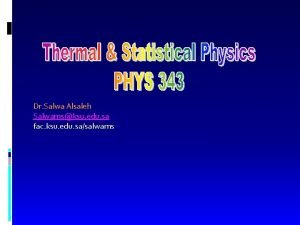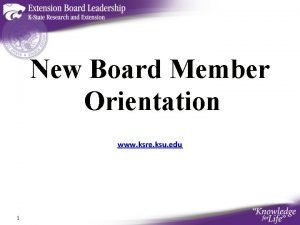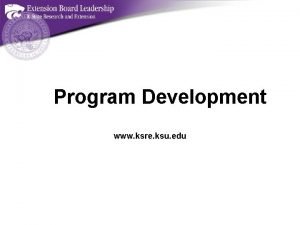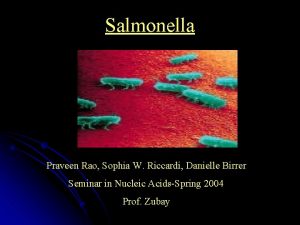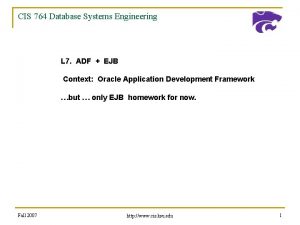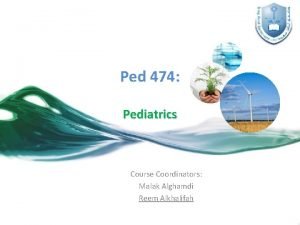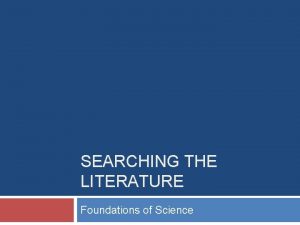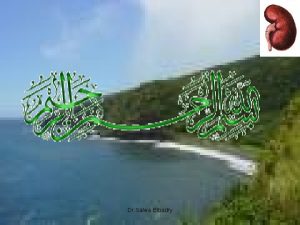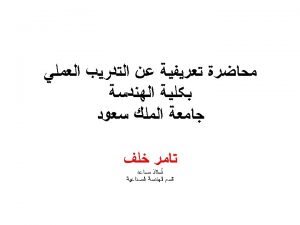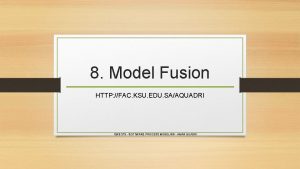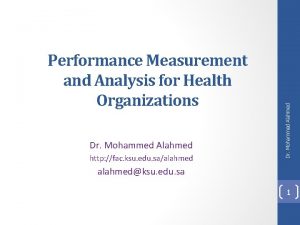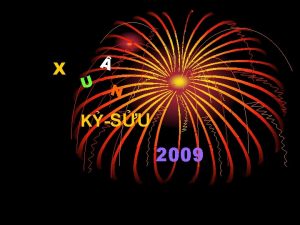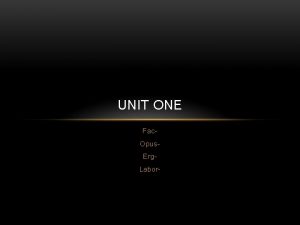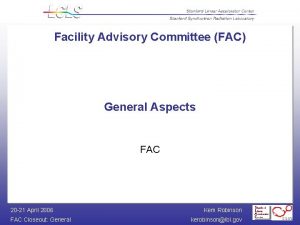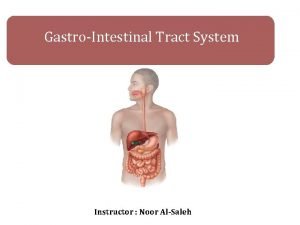Dr Salwa Alsaleh Salwamsksu edu sa fac ksu

























- Slides: 25

Dr. Salwa Alsaleh Salwams@ksu. edu. sa fac. ksu. edu. sa/salwams

Lecture 13 Air Conditioners

Question If you operate a window air conditioner on a table in the middle of a room, the average temperature in the room will 1. become colder 2. become hotter 3. stay the same • 342 phys- Dr. S. Al Saleh • 3

Observations About Air Conditioners They cool room air on hot days They emit hot air from their outside vents They consume lots of electric power They are less efficient on hotter days They can sometimes heat houses, too • 342 phys- Dr. S. Al Saleh • 4

Heat Machines Air conditioners use work to transfer heat from cold to hot are a type of heat pump Automobiles use flow of heat from hot to cold to do work are a type of heat engine • 342 phys- Dr. S. Al Saleh • 5

Thermodynamics Rules governing thermal energy flow Relationships between thermal energy and mechanical work disordered energy and ordered energy Codified in four laws of thermodynamics • 342 phys- Dr. S. Al Saleh • 6

0 th Law about Thermal Equilibrium “If two objects are in thermal equilibrium with a third object, then they are in thermal equilibrium with each other. ” • 342 phys- Dr. S. Al Saleh • 7

1 st Law about Conservation of Energy “Change in internal energy equals heat in minus work out” where: Internal energy: thermal + stored energies Heat in: heat transferred into object Work out: external work done by object • 342 phys- Dr. S. Al Saleh • 8

Order versus Disorder It is easy to convert ordered energy into thermal (disordered) energy It is hard to converting thermal energy into ordered energy Statistically, order to disorder is one-way • 342 phys- Dr. S. Al Saleh • 9

Entropy is measure of object’s disorder Includes both thermal and structural disorders Isolated system’s disorder never decreases But entropy can move or be transferred • 342 phys- Dr. S. Al Saleh • 10

2 nd Law about Disorder (Entropy) “Entropy of a thermally isolated system never decreases” • 342 phys- Dr. S. Al Saleh • 11

3 rd Law about Entropy and Temperature “An object’s entropy approaches zero as its temperature approaches absolute zero” • 342 phys- Dr. S. Al Saleh • 12

More on the 2 nd Law According to the 2 nd Law: Entropy of a thermally isolated system can’t decrease But entropy can be redistributed within the system Part of the system can become hotter while another part becomes colder! • 342 phys- Dr. S. Al Saleh • 13

Natural Heat Flow Heat naturally flows from hot to cold Removing heat from a hot object, ¯ entropy Adding heat to a cold object, entropy Entropy of combined system increases 1 J of thermal energy is more disordering to a cold object than to a hot object • 342 phys- Dr. S. Al Saleh • 14

Unnatural Heat Flow Heat can’t naturally flow from cold to hot Removing heat from cold object, ¯ entropy Adding heat to hot object, entropy More entropy removed than added Energy is conserved, but ¯ total entropy To save 2 nd law, we need more entropy Ordered energy must become disordered • 342 phys- Dr. S. Al Saleh • 15

Air conditioners, Part 1 Moves heat against its natural flow Flows from cold room air to hot outside air Converts ordered into disordered energy Doesn’t decrease the world’s total entropy! Uses fluid to transfer heat – working fluid Fluid absorbs heat from cool room air Fluid releases heat to warm outside air • 342 phys- Dr. S. Al Saleh • 16

Air conditioners, Part 2 Evaporator – located in room air transfers heat from room air to fluid Condenser – located in outside air transfers heat from fluid to outside air Compressor – located in outside air does work on fluid and creates entropy • 342 phys- Dr. S. Al Saleh • 17

Evaporator, Part 1 Heat exchanger made from long metal pipe Fluid approaches evaporator as a high pressure liquid near room temperature A constriction reduces the fluid’s pressure Fluid enters evaporator as a low pressure liquid near room temperature • 342 phys- Dr. S. Al Saleh • 18

Evaporator, Part 2 Working fluid evaporates in the evaporator Breaking bonds uses thermal energy Fluid becomes colder gas Heat flows from room air into fluid Fluid leaves evaporator as a low pressure gas near room temperature Heat has left the room! • 342 phys- Dr. S. Al Saleh • 19

Compressor Working fluid enters compressor as a low pressure gas near room temperature Compressor does work on fluid Pushes gas inward as the gas moves inward Gas temperature rises (first law) Ordered energy becomes disordered energy Fluid leaves compressor as hot, high pressure gas • 342 phys- Dr. S. Al Saleh • 20

Condenser, Part 1 Heat exchanger made from metal pipe Fluid enters condenser as a hot, high pressure gas heat flows from fluid to outside air • 342 phys- Dr. S. Al Saleh • 21

Condenser, Part 2 Working Fluid condenses in condenser forming bonds releases thermal energy Fluid becomes hotter liquid More heat flows from fluid into outside air Fluid leaves condenser as high-pressure room-temperature liquid Heat has reached the outside air! • 342 phys- Dr. S. Al Saleh • 22

Air conditioner Overview Evaporator – located in room air transfers heat from room air to fluid Compressor – located in outside air does work on fluid, so fluid gets hotter Condenser – located in outside air transfers heat from fluid to outside air, including thermal energy extracted from inside air and thermal energy added by compressor • 342 phys- Dr. S. Al Saleh • 23

Question If you operate a window air conditioner on a table in the middle of a room, the average temperature in the room will 1. become colder 2. become hotter 3. stay the same • 342 phys- Dr. S. Al Saleh • 24

Summary About Air Conditioners They pump heat from cold to hot They don’t violate thermodynamics They consume ordered energy They are most efficient for small temperature differences • 342 phys- Dr. S. Al Saleh • 25
 Https://fac.ksu.edu.sa
Https://fac.ksu.edu.sa Fac.ksu.edu.sa
Fac.ksu.edu.sa Ksu.edu.tw
Ksu.edu.tw Mohammed
Mohammed Ksu orientation
Ksu orientation Ksu.edu.tw
Ksu.edu.tw Ksu.edu.tw
Ksu.edu.tw Nacada.ksu.edu
Nacada.ksu.edu Ksu.edu.tw
Ksu.edu.tw Ksre.ksu.edu
Ksre.ksu.edu Ksu.edu.tw
Ksu.edu.tw Icity.ksu.edu.sa
Icity.ksu.edu.sa Dr salwa malik
Dr salwa malik Salwa touma
Salwa touma Dr salwa ibrahim
Dr salwa ibrahim Salwa touma
Salwa touma Typhoid mary
Typhoid mary Dr salwa
Dr salwa Edu.sharif.edu
Edu.sharif.edu Obe engineering ksu
Obe engineering ksu Dxr ksu
Dxr ksu Ksu fye resources
Ksu fye resources Ksu supersearch
Ksu supersearch Ksu stingers menu
Ksu stingers menu üwww
üwww Kennesaw state university counseling
Kennesaw state university counseling


